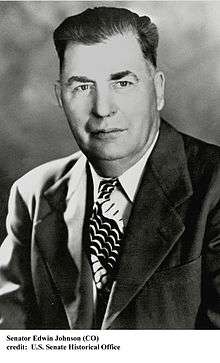Edwin C. Johnson
| The Honorable Edwin C. Johnson | |
|---|---|
 | |
| 26th and 34th Governor of Colorado | |
|
In office January 11, 1955 – January 8, 1957 | |
| Lieutenant | Stephen L.R. McNichols |
| Preceded by | Daniel I.J. Thornton |
| Succeeded by | Stephen L.R. McNichols |
|
In office January 10, 1933 – January 1, 1937 | |
| Lieutenant | Ray Herbert Talbot |
| Preceded by | William Herbert Adams |
| Succeeded by | Ray Herbert Talbot |
| United States Senator from Colorado | |
|
In office January 3, 1937 – January 3, 1955 | |
| Preceded by | Edward P. Costigan |
| Succeeded by | Gordon L. Allott |
| 25th Lieutenant Governor of Colorado | |
|
In office 1931–1933 | |
| Governor | Billy Adams |
| Preceded by | George Milton Corlett |
| Succeeded by | Ray Herbert Talbot |
| Personal details | |
| Born |
January 1, 1884 Scandia, Republic County Kansas, USA |
| Died |
May 30, 1970 (aged 86) Denver, Colorado |
| Resting place | Fairmount Mausoleum of Fairmount Cemetery in Denver |
| Political party | Democratic |
| Profession | Railroad dispatcher; Baseball official |
| Religion | Lutheran |
| Signature |
 |
Edwin Carl Johnson (January 1, 1884 – May 30, 1970) was a Democrat who served as both governor and U.S. senator from the U.S. state of Colorado.
Background
Edwin Carl Johnson was born in Scandia in Republic County in northern Kansas. As a child, he moved with his family to Lincoln, Nebraska. Johnson attended Lincoln High School under the tutelage of William Jennings Bryan, who was serving as a substitute teacher. After graduation in 1903, Johnson pursued his dream of becoming a railroad man, and after numerous positions became a train dispatcher/telegrapher at Fairmont in Fillmore County in southeastern Nebraska. In 1909, Johnson contracted tuberculosis and was advised to relocate to Colorado, where the climate was believed helpful in his medical situation.
Career
Beginning in 1923, Johnson served in the Colorado House of Representatives for four terms. He was lieutenant governor from 1931 to 1933. He represented Colorado for three terms in the United States Senate from 1937 until 1955, during which time from 1937 to 1940 he was an intraparty critic of the New Deal policies of U.S. President Franklin D. Roosevelt.[1] Johnson served as the 26th and 34th governor of Colorado from January 10, 1933 until January 1, 1937 and from January 12, 1955 until January 8, 1957.
He was perhaps best known for making a speech on the Senate floor criticizing the extramarital affair of actress Ingrid Bergman, who at the time was married to Petter Lindström. Bergman's affair with Italian director Roberto Rossellini became a cause celebre as a result of Johnson's speech, forcing her to relocate to Europe for several years until her return to Hollywood in the 1956 blockbuster film Anastasia. In 1972, Senator Charles H. Percy of Illinois entered an apology into the Congressional Record for the attack made on Bergman twenty-two years earlier.
Johnson was also the President of the Western League, a Class A baseball league, from 1947 to 1955. He was instrumental in the construction of Bears Stadium / Mile High Stadium, and was inducted in 1968 into the Colorado Sports Hall of Fame. He died in Denver and is interred at the Fairmount Mausoleum at Fairmount Cemetery in Denver. The eastbound bore of the Eisenhower-Johnson Memorial Tunnel is named for Johnson.
References
- ↑ David M. Jordan, FDR, Dewey, and the Election of 1944 (Blomington: Indiana University Press, 2011), p. 276, ISBN 978-0-253-35683-3
External links
- Governor Edwin Carl Johnson Collection at the Colorado State Archives
- "Colorado Governor Edwin Carl Johnson," National Association of Governors biography
- Edwin C. Johnson at the Biographical Directory of the United States Congress
- Edwin C. Johnson at Find a Grave
- Guide to the Johnson papers at the University of Denver Retrieved 2014-09-26.
Other sources
- McCarthy, William T. Horse Sense: The Divided Politics of Edwin C. Johnson, 1923 - 1954 (Greeley, Co.: University of Northern Colorado, Unpublished Masters Thesis, 1996)
- McCarty, Patrick Fargo Big Ed Johnson: A Political Portrait (Boulder, Co.: University of Colorado, Unpublished Master’s Thesis, 1958)
| Political offices | ||
|---|---|---|
| Preceded by George Milton Corlett |
Lieutenant Governor of Colorado 1931–1933 |
Succeeded by Ray Herbert Talbot |
| Preceded by William Herbert Adams |
Governor of Colorado 1933–1937 |
Succeeded by Ray Herbert Talbot |
| Preceded by Dan Thornton |
Governor of Colorado 1955–1957 |
Succeeded by Stephen L.R. McNichols |
| United States Senate | ||
| Preceded by Edward P. Costigan |
U.S. Senator (Class 2) from Colorado 1937–1955 Served alongside: Alva B. Adams, Eugene D. Millikin |
Succeeded by Gordon L. Allott |
| ||||||||||||
| ||||||||||||||||||||||||
|

